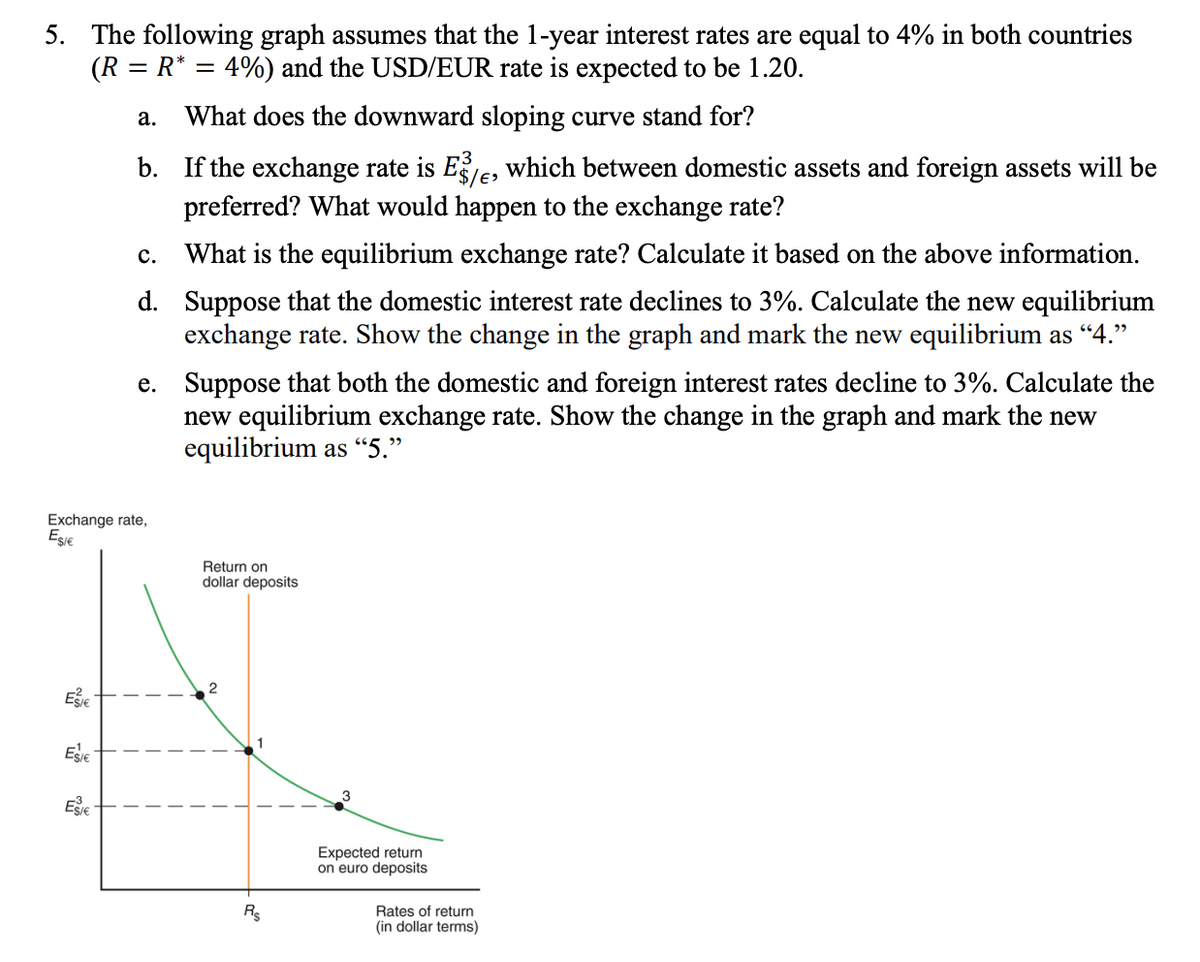5. The following graph assumes that the 1-year interest rates are equal to 4% in both countries (R = R* = 4%) and the USD/EUR rate is expected to be 1.20. а. What does the downward sloping curve stand for? b. If the exchange rate is Ee, which between domestic assets and foreign assets will be preferred? What would happen to the exchange rate? с. What is the equilibrium exchange rate? Calculate it based on the above information.
5. The following graph assumes that the 1-year interest rates are equal to 4% in both countries (R = R* = 4%) and the USD/EUR rate is expected to be 1.20. а. What does the downward sloping curve stand for? b. If the exchange rate is Ee, which between domestic assets and foreign assets will be preferred? What would happen to the exchange rate? с. What is the equilibrium exchange rate? Calculate it based on the above information.
Brief Principles of Macroeconomics (MindTap Course List)
8th Edition
ISBN:9781337091985
Author:N. Gregory Mankiw
Publisher:N. Gregory Mankiw
Chapter13: Open-economy Macroeconomics: Basic Concepts
Section: Chapter Questions
Problem 6PA
Related questions
Question

Transcribed Image Text:5. The following graph assumes that the 1-year interest rates are equal to 4% in both countries
(R = R* = 4%) and the USD/EUR rate is expected to be 1.20.
а.
What does the downward sloping curve stand for?
b. If the exchange rate is Ee, which between domestic assets and foreign assets will be
preferred? What would happen to the exchange rate?
с.
What is the equilibrium exchange rate? Calculate it based on the above information.
d. Suppose that the domestic interest rate declines to 3%. Calculate the new equilibrium
exchange rate. Show the change in the graph and mark the new equilibrium as “4."
e. Suppose that both the domestic and foreign interest rates decline to 3%. Calculate the
new equilibrium exchange rate. Show the change in the graph and mark the new
equilibrium as “5."
Exchange rate,
Egie
Return on
dollar deposits
Expected return
on euro deposits
Rs
Rates of return
(in dollar terms)
2.
Expert Solution
This question has been solved!
Explore an expertly crafted, step-by-step solution for a thorough understanding of key concepts.
Step by step
Solved in 5 steps

Recommended textbooks for you

Brief Principles of Macroeconomics (MindTap Cours…
Economics
ISBN:
9781337091985
Author:
N. Gregory Mankiw
Publisher:
Cengage Learning

Principles of Economics (MindTap Course List)
Economics
ISBN:
9781305585126
Author:
N. Gregory Mankiw
Publisher:
Cengage Learning

Principles of Macroeconomics (MindTap Course List)
Economics
ISBN:
9781305971509
Author:
N. Gregory Mankiw
Publisher:
Cengage Learning

Brief Principles of Macroeconomics (MindTap Cours…
Economics
ISBN:
9781337091985
Author:
N. Gregory Mankiw
Publisher:
Cengage Learning

Principles of Economics (MindTap Course List)
Economics
ISBN:
9781305585126
Author:
N. Gregory Mankiw
Publisher:
Cengage Learning

Principles of Macroeconomics (MindTap Course List)
Economics
ISBN:
9781305971509
Author:
N. Gregory Mankiw
Publisher:
Cengage Learning

Economics: Private and Public Choice (MindTap Cou…
Economics
ISBN:
9781305506725
Author:
James D. Gwartney, Richard L. Stroup, Russell S. Sobel, David A. Macpherson
Publisher:
Cengage Learning

Macroeconomics: Private and Public Choice (MindTa…
Economics
ISBN:
9781305506756
Author:
James D. Gwartney, Richard L. Stroup, Russell S. Sobel, David A. Macpherson
Publisher:
Cengage Learning

Principles of Economics, 7th Edition (MindTap Cou…
Economics
ISBN:
9781285165875
Author:
N. Gregory Mankiw
Publisher:
Cengage Learning